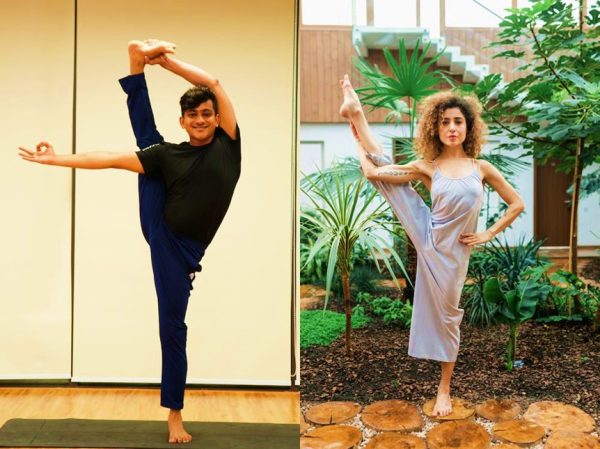
Benefits Of Practicing Advanced Bird Of Paradise Pose Svarga Dvijasana
The Bird of Paradise yoga pose offers a variety of physical and mental benefits, making it a valuable addition to yoga practice for those who have developed the strength and flexibility required to perform the pose. The “Bird of Paradise” is a challenging and advanced yoga pose that requires strength, flexibility, concentration and balance.
Sanskrit name: Svarga Dvijasana (Svarga = paradise, dvija, meaning =twice born)
Benefits of practicing Bird of paradise yoga pose are:
- Strengthens muscles: Bird of paradise requires strength in the legs, core, and shoulders. The pose engages and strengthens the quadriceps, hamstrings, glutes, and abdominal muscles.
- Improves balance and coordination: Balancing on one leg while extending the other leg and maintaining a bind challenges your balance and coordination. Regular practice of this pose can help improve these skills.
- Increases flexibility: This pose demands flexibility, particularly in the hamstrings, hips, and shoulders. Consistent practice can lead to improved flexibility in these areas.
- Hip opener: The transition from Garland pose to Bird of paradise involves a deep hip-opening movement. This can help increase flexibility in the hip joints and alleviate tightness in the hips.
- Enhances shoulder mobility: The bind in this pose requires a degree of shoulder flexibility and mobility. This can be beneficial for individuals looking to open chest and strengthen the shoulders.
- Encourages concentration: Balancing poses like Bird of paradise require focus and concentration. Practicing this pose can help calm the mind and improve mental focus.
- Stimulates digestive organs: The twisting action involved in the pose can stimulate the abdominal organs, potentially aiding digestion and promoting a healthy digestive system.
- Promotes mind and body connection: Like many yoga poses, it encourages mindfulness and the integration of breath with movement. This can promote a deeper mind-body connection.
- Stress relief: Engaging in challenging yoga poses can help release tension and stress. The focus required for practicing this advanced pose can provide a mental break and contribute to a sense of relaxation.
- Patience and perseverance: Achieving the Bird of paradise may take time and consistent practice. This can foster patience and perseverance on the yoga journey, both on and off the mat.
How to perform Bird of paradise pose? Here’s a step-by-step guide on how to perform the pose:
- Warm-up: Before attempting the Bird of paradise pose, it’s crucial to warm up your body. Focus on stretching your hamstrings, hips, and shoulders.
- Mountain pose (Tadasana): Start in Mountain pose, standing tall with your feet hip-width apart, and engage your core.
- Chair pose (Utkatasana): Bend your knees and lower your hips as if you are sitting in an imaginary chair. Keep your weight in your heels and extend your arms overhead.
- Garland pose (Malasana): Transition from Chair pose to Garland pose by bringing your palms together in front of your chest and lower your torso between your thighs. This helps to open up the hips.
- Bind your hands: While in Garland pose, reach your right arm behind your right leg and your left arm behind your left leg. Clasp your hands together, creating a bind.
- Shift weight and lift: Shift your weight onto your right foot while keeping the bind with your hands. Start to lift your left foot off the mat, bringing your knee towards your chest.
- Extend the leg: Slowly begin to straighten your left leg, keeping it extended in front of you. This requires flexibility in your hamstrings.
- Open up: As you extend your left leg, begin to straighten your torso, turning your chest towards the right. This is the point where your body resembles a “bird in flight or the flower bird of paradise”
- Balance and breathe: Find your balance on your right leg and breathe deeply. Engage your core muscles to help with stability.
- Release and repeat: To come out of the pose, bend your right knee, lower your left leg, and release your hands. Return to Mountain Pose and repeat on the other side.
Remember, the Bird of Paradise pose requires patience, practice, and careful attention to your body. If you are a beginner or have any existing health issues, it’s advisable to work with a qualified yoga instructor for proper alignment and technique.
Image credit:
Photo by Lê Đức: https://www.pexels.com/photo/photo-of-a-smiling-man-exercising-yoga-16131180/ (Free for commercial use)
Photo by Alena Darmel: https://www.pexels.com/photo/a-woman-in-garden-doing-bird-of-paradise-yoga-pose-7222374/ (Free for commercial use)
Author: Sumana Rao | Posted on: January 8, 2024
« New Year Resolutions: Suggestions to Honor your Body and Mind Understanding And Addressing Passive Aggressive Behavior »






















Write a comment